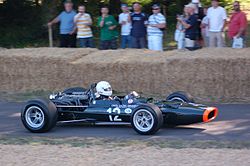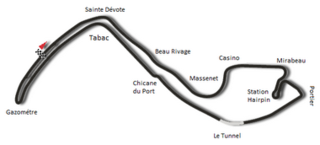
The 1968 Monaco Grand Prix was a Formula One motor race held at the Monte Carlo Circuit on 26 May 1968. It was race 3 of 12 in both the 1968 World Championship of Drivers and the 1968 International Cup for Formula One Manufacturers. The race was won by Lotus driver Graham Hill, who started from pole position. Richard Attwood, driving for BRM, gained second place and fastest lap, while Lucien Bianchi finished in third position in a Cooper, in what was to be these two drivers' only podium finishes.

The 1968 Italian Grand Prix was a Formula One motor race held at the Monza Autodrome on 8 September 1968. It was race 9 of 12 in both the 1968 World Championship of Drivers and the 1968 International Cup for Formula One Manufacturers. The 68-lap race was won by McLaren driver Denny Hulme after he started from seventh position. Johnny Servoz-Gavin finished second for the Matra team and Ferrari driver Jacky Ickx came in third.

Richard James David "Dickie" Attwood is a British motor racing driver from England. During his career he raced for the BRM, Lotus and Cooper Formula One teams. He competed in 17 World Championship Grands Prix, achieved one podium and scored a total of 11 championship points. He was also a successful sports car racing driver and won the 1970 24 Hours of Le Mans race, driving a Porsche 917, the first of Porsche's record 19 victories at the famous race.

The BRM P261, also known as the BRM P61 Mark II, is a Formula One motor racing car, designed and built by the British Racing Motors team in Bourne, Lincolnshire, England. The BRM P261 was introduced for the 1964 Formula One season, and its design was an evolution of Tony Rudd's one-off BRM P61 car of 1963. The P261 had a relatively long racing career; variants of the car were still being entered for Formula One World Championship Grands Prix as late as 1968. During the course of their front-line career, BRM P261s won six World Championship races, in the hands of works drivers Graham Hill and Jackie Stewart, and finished second in both the Drivers' and Constructors' Championship standings in 1964 and 1965. Stewart, Hill and Richard Attwood also used works P261s to compete in the Tasman Series in 1966. The BRMs dominated, with Stewart winning four, Hill two, and Attwood one of the 1966 Tasman Series' eight races. Stewart also won the title. The works-backed Reg Parnell Racing team returned in 1967 with Stewart and Attwood, where Stewart added another two wins to his tally. In terms of races won and total championship points scored, the P261 was the most successful car in BRM's history.
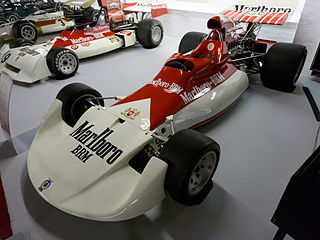
The BRM P180 was a Formula One racing car, built by BRM and designed by Tony Southgate which raced in the 1972 Formula One season. It was powered by a BRM 3.0-litre V12 engine. One of the main features of the P180 was that the radiators had moved to the rear of the car, allowing the nose of the car to be very wide and flat. It competed in five World Championship Grands Prix, with a total of seven individual entries. The car scored no World Championship points, its best finish being eighth at the 1972 Italian Grand Prix.

The BRM P160 was a Formula One racing car designed by Tony Southgate for the British Racing Motors team, which raced in the 1971, 1972, 1973 and 1974 Formula One seasons. It was powered by a 3.0-litre V12 engine.

The BRM P138 was a Formula One racing car designed by Len Terry which raced in the 1968 and 1969 Formula One seasons. It was powered by a 3.0-litre V12 engine.

The BRM P133 was a Formula One racing car which raced in the 1968 and 1969 Formula One seasons.
The Brabham BT48 was a Formula One racing car designed by Gordon Murray and raced by the Brabham team. The car, powered by a 12-cylinder Alfa Romeo engine, competed in the 1979 Formula One season. The intended plan was to run the BT47 but the FIA outlawed it because it had a Chaparral 2J-type box rear end with twin variable geometry fans on the rear to maximize ground effect, so Murray designed the BT48 instead.

The Hesketh 308C was a Formula One racing car designed by Harvey Postlethwaite and used by Hesketh Racing in the latter stages of the 1975 Formula One season. The car featured the rubber suspension which Postlethwaite had pioneered on the preceding 308B model and a Ford-Cosworth DFV engine. In 1976, the car was acquired by Wolf–Williams Racing and rebranded as the Wolf–Williams FW05.

The Matra MS10 is a Formula One car entered by the Matra International team during the 1968 Formula One season. It, along with its V12-powered sibling MS11, was Matra's first purpose-built F1 car and won three races in 1968, taking Jackie Stewart to second place in the Drivers' Championship and Matra International to third place in the Constructors' Championship.

The Lola T370 was a Formula One car designed by Andy Smallman and used by Embassy Hill in the 1974 season and the early part of the 1975 season. After an unsuccessful 1973 with a customer Shadow DN1, the Embassy Hill team commissioned its own cars from Lola. The T370 was largely based on Formula 5000 designs, and looked similar to Lola's F5000 cars, although it sported an extremely large airbox. Embassy Hill had two cars for Graham Hill and Guy Edwards. The car was tested well before the end of 1973 in readiness for the January start to the 1974 season.

The Surtees TS7 was a Formula One car used by Surtees during the 1970 and 1971 Formula One seasons. It was designed by John Surtees, Shahab Ahmed and Peter Connew.

The Williams FW was a Formula One car used by Frank Williams Racing Cars during the 1973, 1974 and 1975 seasons. It was designed by John Clarke.

The Fittipaldi FD was a series of Formula One chassis designed by Richard Divila and used by Fittipaldi Automotive in the 1975, 1976 and 1977 seasons. The initial chassis was designated Fittipaldi FD01 and there were three minor developments designated, Fittipaldi FD02, Fittipaldi FD03 and Fittipaldi FD04 respectively. FD series cars competed in 37 races making 43 individual entries in total. The chassis achieved a best finish of fourth place at both the 1977 Argentine and Brazilian Grands Prix driven on each occasion by former World Champion and joint team-owner Emerson Fittipaldi. It scored a total of 11 World Championship points.
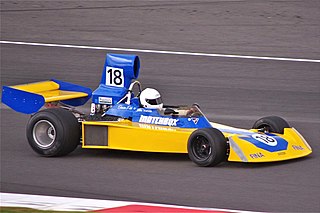
The Surtees TS16 was a Formula One car used by Surtees during the 1974, 1975 and 1976 Formula One seasons. It was designed by John Surtees.

The Surtees TS9 was a Formula One car used by Surtees during the 1971, 1972 and 1973 Formula One seasons. It was designed by John Surtees and Peter Connew.
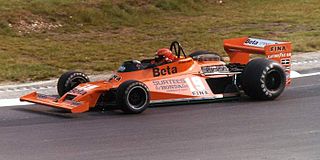
The Surtees TS20 was a Formula One car used by Surtees during the 1978 Formula One season. It was designed by John Surtees and Ken Sears.

The Surtees TS14 was a Formula One car used by Surtees during the 1972 and 1973 Formula One seasons. It was designed by John Surtees.

The Surtees TS19 was a Formula One (F1) car used by Surtees during the 1976, 1977 and 1978 F1 seasons. It was designed by John Surtees and Ken Sears.
